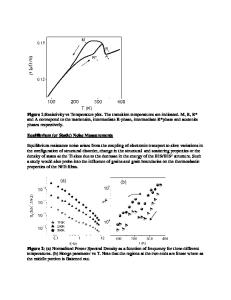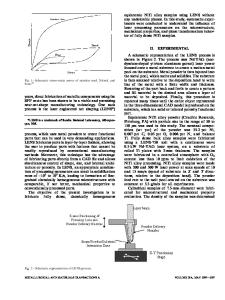Mechanical and Microstructural Characterization of Porous NiTi Shape Memory Alloys
- PDF / 1,687,791 Bytes
- 10 Pages / 593.972 x 792 pts Page_size
- 94 Downloads / 417 Views
I.
INTRODUCTION
IN the fabrication of prostheses for biomedical applications, it is interesting to consider the use of porous materials in order to favor bone integration and mechanical coupling. Two important aspects have to be considered in the selection of implant materials for bone replacement. First, the materials should be chemically inert and biocompatible. The present study did not undertake an examination of these aspects with respect to nickel-titanium (NiTi) alloys. It is however generally accepted that NiTi has a similar biocompatibility as titanium and stainless steels,[1] two materials greatly used in the bone implant applications. Second, an implant must have an elastic modulus similar to that of bone because the bone surrounding the implants must continue to carry load after the healing process. If the implant is much stiffer than the bone, the implant will support a greater amount of stress. In response, the body will eliminate the unsolicited bone tissue and cause eventual loosening, unseating and failure of the implant. Bone has an elastic modulus ranging from 3 to 20 GPa,[2] while for most metals and ceramics, elastic moduli range from 100 to 400 GPa. Furthermore, the linear stress-strain characteristics of metallic implants do not match the nonlinear stress-strain behavior of the bones, which also results in implant loosening. O. SCALZO, Engineer, is with the Materials Characterization Department, Pratt & Whitney Canada, Longueuil, PQ, J4G 1A1, Canada. S. TURENNE, Professor, is with the Department of Mechanical Engineering, E´cole Polytechnique, Montreal, PQ, H3C 3A7, Canada. Contact e-mail: [email protected] M. GAUTHIER, Research Officer, is with the Industrial Materials Institute, National Research Council Canada, Boucherville, PQ, J4B 6Y4, Canada. V. BRAILOVSKI, Professor, is with the Department of Mechanical Engineering, E´cole de Technologie Supe´rieure, Montreal, PQ, H3C 1K3, Canada. Manuscript submitted December 14, 2007. Article published online July 14, 2009
Another aspect to be considered is the bone-implant interface. To provide a way for living bone to attach itself permanently to an implant, the replacement material should preferentially have a porous structure. It has been proven that titanium porous implants demonstrate an important gain in promoting tissue ingrowth and firm securing of the implant.[3] Moreover, an adequate pore structure would reduce the effective elastic modulus of the metallic material and the elastic mismatch between the bone and the implant. Among the candidate materials available for such applications, NiTi shape memory alloys (SMAs) are characterized by a suitable elastic modulus in porous form for matching that of some bone types. While NiTi alloys have an elastic modulus ranging from 30 to 80 GPa in the fully dense state,[4] it can be lowered to 2 to 10 GPa in porous form.[5,6] Moreover, their larger pseudo-elastic deformation capacity compared to that of other metals and alloys represents an important advantage for the mechanical behavior of prostheses.[7
Data Loading...











